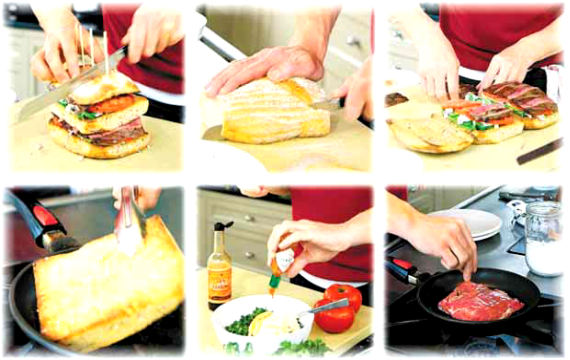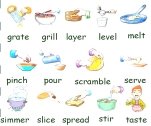План-конспект уроку англійської мови на тему: Улюблені рецепти
Практична задача: 1) ознайомити з новою тематичною лексикою (to boil, to fry, to steam, to slice, to mash, to top, to toast, to grill, to roast) та організувати вправляння у її вживанні в мовленні;
2) організувати аудіювання тематичного тексту «Ann's Recipe» з вилученням основної інформації у пред'явленні вчителя;
Освітні задачі: розширяти знання учнів про особливості британської кухні; розширяти філологічний кругозір учнів шляхом ознайомлення з новою лексикою; сприяти усвідомленню учнями особливостей свого мислення; підвищувати загальну культуру спілкування; залучати до діалога культур.
Розвиваючі задачі: розвивати мовленнєві здібності учнів – фонематичний слух, мовленнєву реакцію; розвивати інформаційну культуру учнів; інтелектуальні здібності (логічне мислення, уяву, увагу, слухову та довгострокову пам'ять).
Виховні задачі: виховувати культуру спілкування; формувати позитиві риси характеру: наполегливість у доланні труднощів, працелюбність, старанність, активність; виховувати позитивне ставлення до іноземної мови, культури народу; виховувати розуміння важливості оволодіння англійською мовою та потреби користування нею як засобом спілкування.
Засоби навчання: підручник: Несвіт А.М. Англійська мова: Ми вивчаємо англійську мову: підруч. для 10 кл.
загальноосвіт. навч. закл. – К. : Генеза, 2008 – 256 с. : іл.; яблуко; картки зі скоромовками для організації фонетичної зарядки; відеоролик на тему: «Thanksgiving Day»; картки миттєвого пред'явлення для семантизації нових ЛО; відеоролик для організації динамічної паузи; текст для аудіювання; картки з новими словами для легшого розуміння тексту для аудіювання; текст для перевірки розуміння почутого.
ПЛАН-КОНСПЕКТ УРОКУ АНГЛІЙСЬКОЇ МОВИ
До проведення уроку допущено:
(підпис вчителя англ. мови) __________________
(Евтушевська В.М.)
Урок № 30 Дата: 15.11.2013 р. (перший урок) Клас: 10-А клас
Тема уроку: Їжа
Підтема: Улюблені рецепти
Практична задача: 1) ознайомити з новою тематичною лексикою (to boil, to fry, to steam, to slice, to mash, to top, to toast, to grill, to roast) та організувати вправляння у її вживанні в мовленні;
2) організувати аудіювання тематичного тексту «Ann’s Recipe» з вилученням основної інформації у пред’явленні вчителя;
Освітні задачі: розширяти знання учнів про особливості британської кухні; розширяти філологічний кругозір учнів шляхом ознайомлення з новою лексикою; сприяти усвідомленню учнями особливостей свого мислення; підвищувати загальну культуру спілкування; залучати до діалога культур.
Розвиваючі задачі: розвивати мовленнєві здібності учнів – фонематичний слух, мовленнєву реакцію; розвивати інформаційну культуру учнів; інтелектуальні здібності (логічне мислення, уяву, увагу, слухову та довгострокову пам’ять).
Виховні задачі: виховувати культуру спілкування; формувати позитиві риси характеру: наполегливість у доланні труднощів, працелюбність, старанність, активність; виховувати позитивне ставлення до іноземної мови, культури народу; виховувати розуміння важливості оволодіння англійською мовою та потреби користування нею як засобом спілкування.
Засоби навчання: підручник: Несвіт А.М. Англійська мова: Ми вивчаємо англійську мову: підруч. для 10 кл.
загальноосвіт. навч. закл. – К. : Генеза, 2008 – 256 с. : іл.; яблуко; картки зі скоромовками для організації фонетичної зарядки; відеоролик на тему: «Thanksgiving Day»; картки миттєвого пред’явлення для семантизації нових ЛО; відеоролик для організації динамічної паузи; текст для аудіювання; картки з новими словами для легшого розуміння тексту для аудіювання; текст для перевірки розуміння почутого.

ХІД УРОКУ
|
Етапи |
Час |
Мовлення вчителя |
Мовлення учнів |
Примітки |
|
І. Початок уроку 1.Організаційний момент Прийом: Активне слухання, відповіді на запитання. Режим: Teacher – class.
2. Фонетична зарядка (на матеріалі скоромовки) а) підготовча робота по пред’явленню скоромовки Прийом: Активне слухання, відповіді на запитання. Режим: Teacher – class.
б) пред’явлення скоромовки вчителем Прийом: Активне слухання. Режим: Teacher – class.
в) хорове промовлення скоромовки за вчителем
3. Мовленнєва зарядка. Мета: введення в мовленнєве середовище. Прийом: бесіда вчителя з учнями. Режим: Teacher – class.
ІІ. Основна частина Задача І: Організація ознайомлення учнів з новими ЛО
Прийом: Активне слухання, відповіді на запитання. Режим: Teacher – class.
Прийом: активне слухання, відповіді на запитання вчителя. Режим: Teacher – class.
а) виконання вправи на з’єднання слів з їх визначенням (с.108, Впр. 7)
Динамічна пауза (за методикою Total Physical Response)
Задача ІІ: Організація аудіюванн тематичного тексту «Ann’s Recipe з вилученням основної інформації у пред’явленні вчителя
а) зняття лексичних труднощів тексту: - пояснення значення деяких слів та виразів;
б) аналіз граматичних явищ.
Прийом: активне слухання
Прийом: відповідi на запитання Режим: Teacher –class.
III. Заключна частина уроку.
|
0,5хв.
2 хв.
1 хв.
2 хв.
2 хв.
4 хв.
4 хв.
4 хв.
0,5хв.
3 хв.
0,5хв.
1 хв.
3 хв.
4 хв.
2 хв.
0,5хв.
3 хв.
5 хв.
1 хв.
0,5хв.
0,5хв.
1 хв.
|
Nice to meet you! Sit down, please.
Thank you very much.
Dear Jane, I’m glad you liked the food. Here’s the recipe which you wanted. It’s from a great cookery book. If cooking for four people you’ll need: 2 onions, 2 or 3 cloves of garlic, 2 fresh green bell peppers, 8 tomatoes, 4 medium red bell peppers, 4 eggs, salt and pepper, and fresh herbs (parsley, celery leaves etc). First, slice the onions and garlic thinly and saute them slowly for 10 to 15 minutes so they become nice and sweet. While the onions are cooking, take the seeds out of the peppers, and then chop them up. Chop the tomatoes as well, then add these to the onions and stir well, adding salt and pepper. Let everything cook slowly. You might need to add water. So it doesn’t stick to the pan. Cover it. After about 10 or 15 minutes, the mixture should be soft. Make four small holes in the mixture for the eggs. Then break the eggs and drop them carefully into the holes without breaking the yolks. Continue cooking until the eggs whites are cooked and then turn off the heat. Finally, chop some fresh herbs and throw them on the top. That’s it! I’ll give you a ring again soon. Ann
Dear Jane, I’m glad you liked the food. Here’s the recipe which you wanted. It’s from a great cookery book. If cooking for four people you’ll need: 2 onions, 2 or 3 cloves of garlic, 2 fresh green bell peppers, 8 tomatoes, 4 medium red bell peppers, 4 eggs, salt and pepper, and fresh herbs (parsley, celery leaves etc). First, slice the onions and garlic thinly and saute them slowly for 10 to 15 minutes so they become nice and sweet. While the onions are cooking, take the seeds out of the peppers, and then chop them up. Chop the tomatoes as well, then add these to the onions and stir well, adding salt and pepper. Let everything cook slowly. You might need to add water. So it doesn’t stick to the pan. Cover it. After about 10 or 15 minutes, the mixture should be soft. Make four small holes in the mixture for the eggs. Then break the eggs and drop them carefully into the holes without breaking the yolks. Continue cooking until the eggs whites are cooked and then turn off the heat. Finally, chop some fresh herbs and throw them on the top. That’s it! I’ll give you a ring again soon. Ann
|
Nice to meet you too!
Mary: - Можливо, варити…?
P1: - Мідний!
P2: - Pot! The translation of this word is горщик, казанок.
Pls: - proper, cup, coffee, copper, pot.
Pls: - Carol brews a proper cup of coffee in a copper coffee pot.
Pls: - Carol brews a proper cup of coffee in a copper coffee pot.
Pls: - Carol brews a proper cup of coffee in a copper coffee pot.
P3: - Carol brews a proper cup of coffee in a copper coffee pot. P4: - Кєрол заварює кофе у металевій кофейній посудині.
P1: - Хто по яблуку в день з’їдає в того доктора не буває.
Dima: - I like apples very much. I try to eat them every day.
Natalie: - I like apples, but as usual I forget to eat them every day.
Ann: - I think, yes. I try to eat more fruits and vegetables, as there are a lot of vitamins.
Pls: - am… Pls: - No, we don’t.
Pls: - Yes!
Dan: - Yes! Of course, I like boiled eggs!
P1: - I like! P2: - I like to eat mash potatoes! P3: - I like fried!
Kate: - I like more grilled meat than roasted.
P1: - I like to eat sliced lemon. P2: - ….
P3: - Me! I like to eat the toasts with jam. P4: - I like it too!
Helen: - We have to read and say which word is being defined. Helen: Remove the skin… I think that it is the verb to peel, знімати кору, очищати фрукти овочі. Kate: - Cut into many pieces… To my mind it is the verb to chop…?
P1: - It is the verb to add.
P2: - To mash!
Nadya: - Cook in water – it is to boil. Cook in oil … is to fry. Oleg: - Cook in the oven without oil or fat. The right variant is c, to roast.
Marc: - Cook in the oven with oil or fat… It is the verb to bake.
Pls: - ah…
- Form banana (x4) - Peel banana! (x4) - Go banana (x4) - Form the apple (x4) - Peel the apple (x4) - Slice the apple (x4) - Form the orange (x4) - Peel the orange (x4) - Squeeze the orange (x4) - Form the corn (x4) - Shuck the corn (x4) - Pop the corn (x4) - Form potato (x4) - Peel potato (x4) - Mash potato (x4)
Pls: - So-so… sometimes.\
P1: - No… P2: - Yes, of course!
Nadya: - Ти маєш додати води?
Mary: - …am… too long sentence. Розбийте яйця та акуратно вилийте їх, не розбиваючи жовтка. Mary: - Thank you.
P1: - A girl writes the letter to her friend Jane. The name of the girl is Ann.
P2: - She writes the recipe for 4 people.
P3: - After about 10 or 15 minutes, the mixture should be soft.
P4: - That she’ll call her soon.
Pls: - Nooo!
Oleg, Marc, Nastya, Nadya: - Thank you, Marina Nickolaevna!
Pls: - Thank you! Bye-bye! |
На дошці черговими записана дата, місяць. В кожного учня на парті лежить скоромовка для організації фонетичної зарядки (див. Додаток №1, с. ).
Діти активно приймають участь.
Діти промовляють хором з а вчителем.
Діти намагаються вимовити скоромовку…
Вчитель відбиває ритм та робить звукове забарвлення скоромовці, роблячи голос гучніше, тише.
Вчитель показує яблуко… Прислів’я виноситься на головний екран телевізора.
В класі тиша…
Під час розповіді вчителя про День подяки на головному екрані (на моніторі) програється відеоролик про День подяки під супровід музики (без диктора) (див. Додаток №2, с. ).
Вчитель одночасно показує картки та зачитує дефініцію певного слова (див. Додаток №3, с. ).
Зміст вправи (див. Додаток №4, с. ).
Вчитель записує домашнє завдання на дошці.
Відеоролик динамічної паузи (див. Додаток №5, с. ) .
Учні та вчитель співають разом, виконуючи певні рухи.
Вчитель роздає картки з новими лексичними одиницями для кращого розуміння тексту
(див. Додаток №6, с. ).
Всі незнайомі слова записані на дошці.
На дошці записані питання стосовно даного тексту-письма (див. Додаток №7, с. ).
Вчитель зачитує листа Анни (зміст листа див. Додаток №8, с. ).
Учні слухають вчителя.
Вчитель пред’являє питання на дошці.
Учні уважно слухають вчителя. Деякі намагаються записати деталі.
Вчитель роздає кожному учню тест (див. Додаток №9, с. ) для індивідуальної роботи учнів.
Вчитель записує домашнє завдання на дошці.
Виставляє оцінки в щоденник. |
Оцінка за урок: Викладач-методист: ______________ (Роман Світлана Володимирівна)
(підпис)



про публікацію авторської розробки
Додати розробку


